Italian EV Uses UltraCapacitor Technology to Assist Energy Storage and Retrieval:BLUECAR
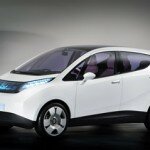
BLUECAR
At the beginning of 2008 Pininfarina and Bolloré set up a 50-50 joint venture with the goal of designing, developing, manufacturing and distributing an electric car with revolutionary technical features and formal qualities. The company considers the BLUECAR, to be not a mere concept car but a forerunner of the vehicle which will go into production in Italy at Pininfarina starting from 2010. Production on a commercial scale will take place between 2011 and 2017, with the forecasted output by 2015 being about 60,000 units.
The vehicle was conceived as a four-seater five-door with an automatic transmission. The BLUECAR is powered by LMP (Lythium Metal Polymere) batteries, combined with an ultracapacitor (device for energy storage ) which is manufactured in the Bolloré plants at Quimper (Francia) and Montreal (Canada). The onboard supercapacitor retrieves and stores energy during braking and makes it available when the vehicle re-starts. This design provides for greater acceleration, an increased range and longer lifespan for the car’s battery.
The LMP battery can be recharged at a traditional mains plug and range is 250 km. At equivalent weight, this battery stores five times more energy than a traditional type and recharges in just a few hours. As it does not require any maintenance, it has a life-span of about 200,000 km and is reported to provide unparalleled safety. The battery is housed below the floorpan and between the two axles. Due to its low centre of gravity, the handling of the vehicle is reportedly outstanding.
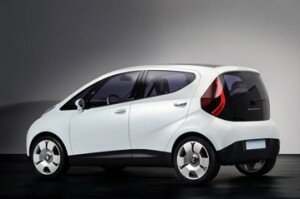
Pinifarina BLUECAR
Part of the car’s hood is covered with high-performance solar panels which help power some of its equipment. All the materials used in the vehicle including, the battery and interior trim have been carefully selected for their low environmental impact and are recyclable or reutilisable. The Bolloré group is also looking into the design of photovoltaic cell panels to be installed in private or public places to allow partial or total recharging of the batteries through solar energy alone.
The company describes the Bluecar design below:
The body of the car is shaped like an elastic shell resting forcefully on the four wheels, arching over its vertical axis and thrust forward by the shape of the sides. This idea of perfectly controlled physical strength is enhanced visually by the arched sills which contribute to the idea of the volumes thrusting forward. In the front view, the distinctive signs of Pininfarina design are seen in the iconic appearance of a vehicle that is strong and sure of itself without being aggressive. The design decisions are perfectly functional to the electric supply, hence the unobtrusive, short and sloping bonnet. The car’s dynamic personality is underlined by the horizontal lighting clusters. At the base of the windscreen, an access hatch for recharging the batteries and for simplified routine maintenance. The wrap-round rear volume highlights the car’s agility and its liking for spurts of speed.
The impression on climbing aboard is that you are in a vehicle that is much roomier than a normal city car: passenger comfort is guaranteed, as in a premium saloon, by four independent seats thanks to the absence of mechanical clutter due to the electric power unit. The interior trim stands out for the quality and precision of its detail and workmanship, a heritage of Pininfarina’s historic tradition. The upholstery, like all the furnishings, is in environmentally-friendly material. The central tunnel, which is both functional and decorative, and is moulded with refined lightness, has an original springboard form which strains forward towards the dashboard and hosts the window controls, the rearview mirror adjustment button and the original drive control which, of course, stands in for the traditional gear-lever.
At the centre of the dash, the clear, readable upper screen provides all essential information: speed, range, state of battery charge. But the virtual heart of the information system is the great touchscreen which brings together 90% of interaction possibilities between the vehicle and its user. Screen graphics are easy on the eye, intuitive and elegant. Just graze the screen to select the control function you require: climate control, audio system, GPS, call for assistance, phone, drive management mode (environment, sport or ice). Finally, a remote control incorporated in a portable phone allows you to monitor the state of the battery and trigger its pre-heating so that the vehicle is immediately ready to start, even after it has been parked a long time.
Popularity: 10% [?]
Short URL: https://greencarmagazine.net/?p=138
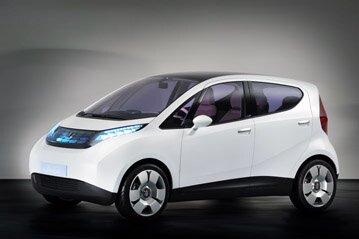
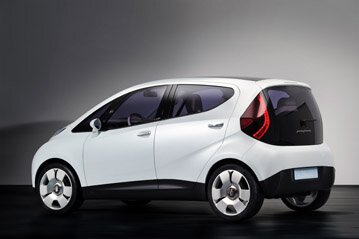
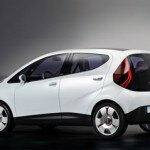





































































































There is no one single technical data in all this fuss. This is pure propaganda. 60,000 cars by 2015 is a false hope. A serious information should give the capacity of the ultracapacitor, for people to calculate . The same for the battery. Repeat: fuss.
[...] from: Italian EV Uses Supercapacitor Technology to Assist Energy Storage … Tags: a-50-50-joint, and-formal, goal, Technology, the-campaigning, venture-with, [...]
I will be back here once again.I like this blog